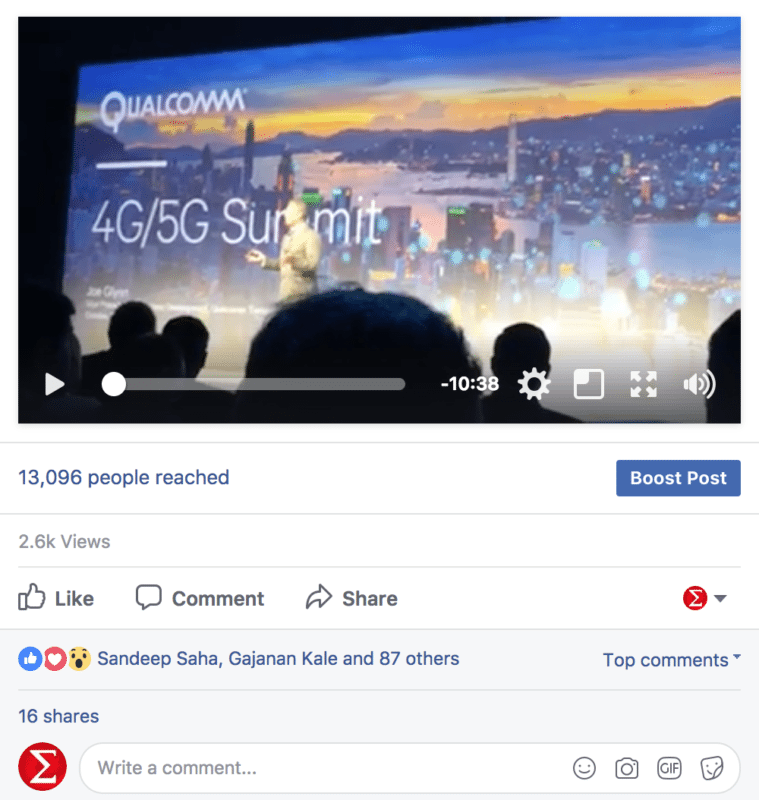The best place to get the answer to that question is at Qualcomm’s 4G/5G summit, which highlights 5G, connectivity, IoT and the connected world. This time, it was at the QCT Kerry Hotel. Opening with an impressive keynote by Cristiano Amon, Executive Vice President and President, the keynote went on to feature senior staff from Qualcomm’s partners (Ericsson, Verizon, Sony, Netgear) coming in to share their experiences on working with this millimetre wave technology. 5G technology definitely looks like it’s on the road to a proper deployment soon (while LTE-A still tries to catch up).
How much progress though?
The benefits 5G is poised to offer is already understood by most of our readers (here’s an intro) – lower latency, higher density, higher speeds, etc. But when we come to the different deployment strategies for 5G, Luce Orsen from Ericsson says that, “One relies on leveraging the existing LTE network while the other relies on building an entire new network.” It is expected that these will be on technology trials in the first half of 2018. By the second half of 2018, we should see early trials around initial 3GPP compliance on LTE, going through the first half of 2019.

Through this keynote we also learnt that 5G use cases also expand operator service opportunities, while plugins deliver 5G technology concepts and interface service opportunities for the benefit of both operators (helps operators in a smooth evolution to 5G) and end users (we know how).
Once 5G is here, it will make available a whole new level of media consumption options. Atish Gude from Ericsson spoke about how while high resolution video is a given, AR and VR have a lot more to gain from 5G. More importantly, a latency of 1ms means that the drawbacks of keeping things on the cloud, like download delays and slow response to changes, will almost completely be taken away.
Challenges and opportunities
In order to achieve all of this, the complexity of these involved RF systems is accelerating. If we look at the number of RF bands and band combinations, there were 16 in early 4G, which then ballooned to 49 in 4G today. There are over 1000 in carrier aggregation combinations for 4G too. However, in 5G, this number is expected to be greater than 10,000.
Kazuo Murata from Sony explained that, “The challenge with millimetre wave is that we require higher gain and therefore need an antenna array. Moreover, to avoid hand effect, we need a higher number of antenna arrays.” As a result, they are working on a small size low power antenna system that mixes RFIC with an antenna array.
We have a few markets in the US and in other markets where we ran some simulations and saw that if you go to dense 4G networks today and run 5G coverage, you start to see some variation of change in coverage — what happens is that millimetre base station takes away traffic from LTE network.
The effect on Automotive
When people get behind the wheel, they open their smartphone and there are numerous ways to tether your car with your phone. We can now see a complete transformation in the car infotainment system moving to proper in car entertainment (god forbid the day we get traffic tickets printed out on our dashboard). Cars are going to be massive nodes for these networks. In the Mercedes Formula 1 team, Qualcomm used Wi-Fi in 5 gig band and Wi-Fi in 50 Gigahertz millimetre band and… they discovered that the Mercedes sends a full Terabyte of data per race. 5G is definitely going to be a boon for future car fleets who will need similar data transfer capacity at a much wider range. The car is going to be a big node on the wireless network for heavy data transmission, even without the people in it using Netflix.
An app in people smartphones and in cars that look at proximity to each other devices through wireless to figure out the chances of colliding with a person even if that person is not in the line of sight of the vehicle that could potentially cause the collision. This will allow vehicles and people to travel more safely.
Cat-M1 and NB1
The same LTE IoT standard has two categories Cat-M1 and NB1. While M1 is optimised for broadest range of IoT applications with high reliability and lower latencies, NB1 on the other hand provides extreme optimisation for low cost lower power low throughput delay tolerant IoT use cases.
Scaling up in performance and mobility is LTE Cat-1 and above which delivers scalable performance and superior mobility for high performance IoT use cases. 5G narrowband is being filled by LTE technologies. 5GNR is reusing a lot of the technologies that gave 4G economies of scale and form an essential part of the 5G platform.
Qualcomm figures that devices will start rolling out with 5G capability by the last quarter of 2019. Looking forward to one?





